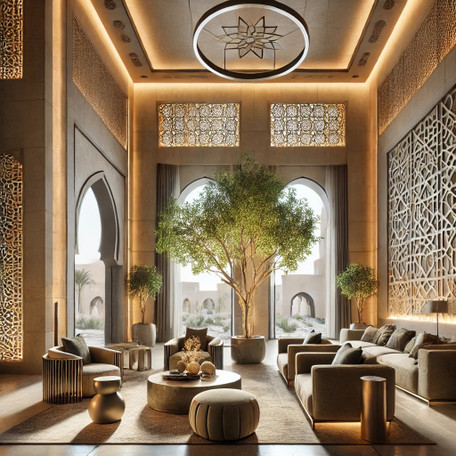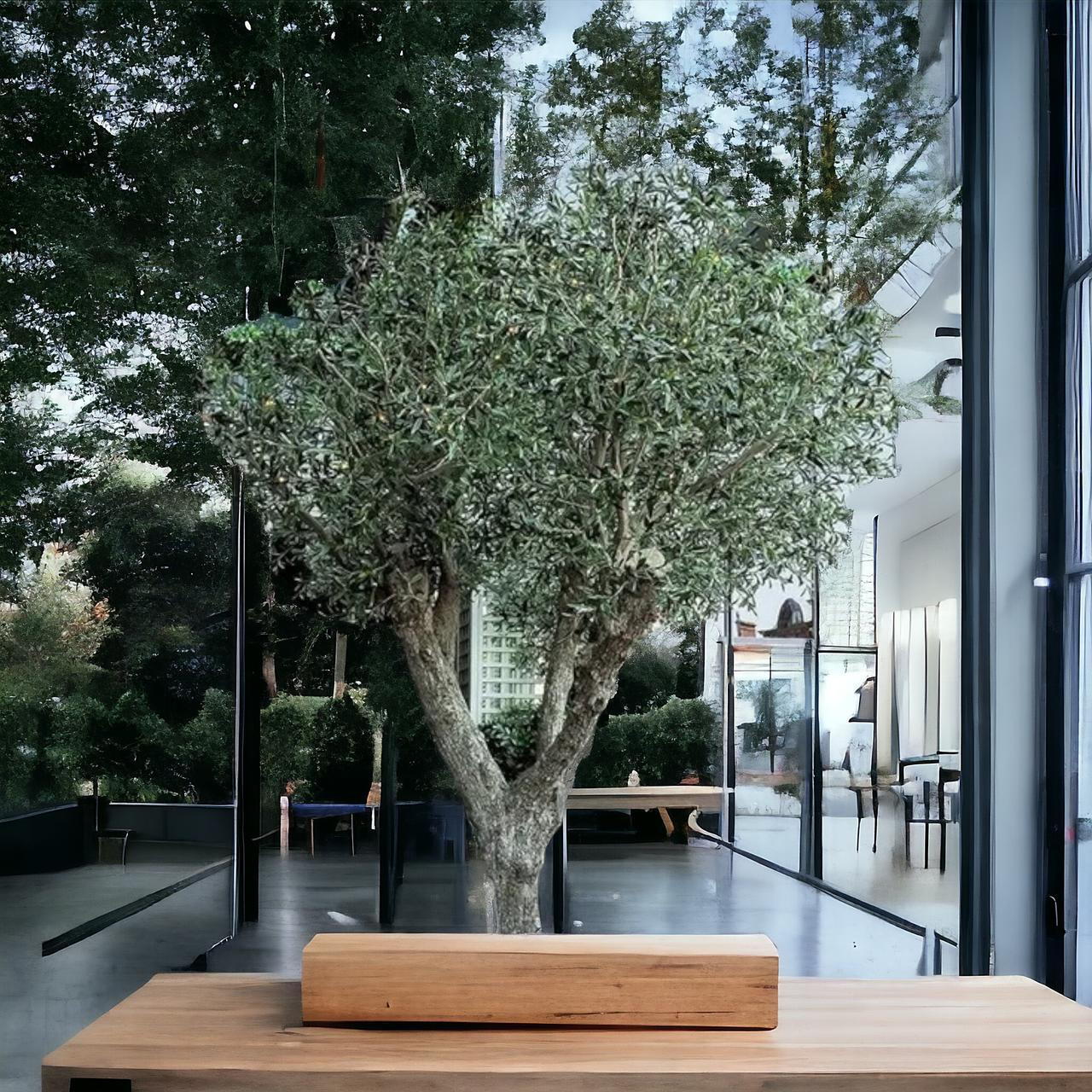Innovative Trends in Interior Design Abu Dhabi: A Fusion of Modern and Traditional Styles
Posted by Elodie Allington - Architect on 8th Sep 2024
In the sprawling, sun-drenched city of Abu Dhabi, a place where ancient traditions meet ultra-modern aspirations, the field of interior design is blossoming into something truly extraordinary. What was once a niche segment reserved for the affluent is now democratized, as innovation, sustainability, and a keen sense of heritage converge to create spaces that are as functional as they are breathtaking. In this article, we will explore how Interior Design Abu Dhabi is evolving, particularly in its innovative fusion of modern and traditional styles. We’ll also take a fascinating detour into the emerging role of artificial trees in both residential and commercial spaces, as these become symbolic of a deeper connection between nature and architecture.
The Architectural Context of Abu Dhabi
To understand the shifting currents in Interior Design Abu Dhabi, one must first grasp the architectural evolution of the city itself. In just a few decades, Abu Dhabi has transformed from a modest desert town into a global metropolis, a skyline punctuated by cutting-edge skyscrapers and iconic structures such as the Louvre Abu Dhabi and Sheikh Zayed Grand Mosque. This rapid development has brought with it a particular design sensibility: one that seeks to reconcile the ultra-modern with deeply rooted Islamic and Bedouin cultural traditions.
The architecture of Abu Dhabi, like the city itself, tells a story of contrasts and harmonies. The gleaming glass towers speak of progress and innovation, while the subtle integration of Islamic geometric patterns, arches, and traditional Arabian elements ensure a continuing dialogue with the past. This delicate balance between the futuristic and the historical is mirrored in the evolving interior design trends of the city. In Interior Design Abu Dhabi, modernism and tradition are not seen as competing forces but as partners in a dance, each enhancing the other’s beauty and purpose.
The Interplay Between Modern and Traditional Elements
One of the most striking features of Interior Design Abu Dhabi is the seamless fusion of modern and traditional styles. This synthesis is not accidental; rather, it is born from the very identity of the city itself. Designers are tasked with creating spaces that speak to Abu Dhabi’s fast-paced, cosmopolitan lifestyle while honoring its cultural and architectural heritage.
- Geometric Patterns and Minimalism: Traditional Islamic art is renowned for its intricate geometric patterns, a symbolic representation of infinity and divine order. These motifs are reinterpreted in modern interiors in Abu Dhabi, where they adorn walls, ceilings, and floors in a minimalist fashion. The result is a space that feels both anchored in history and open to the possibilities of the future. For example, the delicate mashrabiya latticework, once a hallmark of traditional Arabian homes, is often reimagined in sleek metal or glass in contemporary Abu Dhabi interiors, adding texture without overwhelming the eye.
- Earthy Tones and Futuristic Materials: In line with its desert origins, Interior Design Abu Dhabi frequently utilizes earthy tones—sands, ochres, and deep browns—to evoke a sense of place. But these warm hues are juxtaposed against materials like chrome, glass, and polished marble, creating a stunning contrast between the natural and the industrial. This interplay of elements suggests not just a visual dialogue, but a philosophical one: Abu Dhabi’s design ethos is about crafting spaces that are both grounded in tradition and forward-looking.
- Lighting as a Cultural Symbol: In traditional Arabian design, light holds deep cultural significance. Today, Interior Design Abu Dhabi incorporates this principle by using lighting not just as a functional tool but as a symbolic one. Designers often employ large, intricately designed chandeliers made of modern materials such as brushed metal and LED technology but shaped in patterns that echo the lamps of old. The result is a merging of the sacred and the futuristic, casting spaces in a light that feels timeless yet contemporary.
The Rise of Sustainability: Natural and Artificial Trees
One of the most innovative and unexpected trends in Interior Design Abu Dhabi is the growing use of artificial trees. The harsh climate of the UAE makes the cultivation of natural greenery difficult, and the emphasis on sustainability in modern design has led to the creative use of artificial trees to solve this problem. These trees are not mere decorative elements; they are designed with astonishing realism, mimicking the texture, color, and form of real trees while requiring minimal maintenance.
The artificial trees used in Abu Dhabi’s interior spaces often come with integrated lighting and air purification systems, making them not just aesthetically pleasing but functional as well. For instance, in high-end office spaces, artificial trees are installed to bring a sense of calm and nature into otherwise sleek, modern interiors. These trees serve as focal points, often arranged in clusters that mimic small oases, resonating with the historical significance of the desert oasis as a life-sustaining sanctuary in Arabian culture.
In residential spaces, the artificial tree trend has taken on a more personal form. Designers are incorporating trees into indoor courtyards and atriums, creating spaces that serve as the heart of the home. These installations speak to a desire to bring nature indoors in a sustainable way, bridging the gap between Abu Dhabi’s arid exterior and the lushness of traditional Arabian garden spaces. The presence of these trees reinforces the idea that Interior Design Abu Dhabi is not just about aesthetics but about creating environments that foster well-being, balance, and a connection to nature—even if that connection is, in some cases, artificial.
High-Tech Integration: Smart Homes with Traditional Aesthetics
Abu Dhabi is at the forefront of smart home technology, and Interior Design Abu Dhabi reflects this shift. Homes are now being equipped with cutting-edge technology—smart lighting, voice-activated controls, climate regulation systems—that are seamlessly integrated into the design without detracting from the aesthetic appeal.
What makes Abu Dhabi unique, however, is the way this high-tech integration often sits comfortably alongside traditional design elements. For example, smart lighting systems might be embedded in ornate, handcrafted wooden panels that feature traditional Arabian motifs. The technology is invisible, but the craftsmanship is on full display, demonstrating once again the city’s dedication to harmonizing the old with the new.
Similarly, climate control systems—essential in Abu Dhabi’s extreme temperatures—are now designed to be energy-efficient, often drawing inspiration from traditional wind towers (barjeel) used in older Gulf architecture. This clever adaptation of ancient methods into modern technologies is a hallmark of Interior Design Abu Dhabi, where sustainability and tradition go hand in hand.
Cultural Storytelling Through Design
One of the defining features of Interior Design Abu Dhabi is its commitment to cultural storytelling. Every design choice, from the color of the walls to the arrangement of the furniture, tells a story about the people who inhabit the space. This is particularly evident in the choice of artwork, textiles, and accessories, which often reflect the rich tapestry of Arabian history and culture.
- Handwoven Textiles and Rugs: A quintessential element of traditional Arabian interiors, handwoven textiles and carpets continue to hold a place of prominence in modern Abu Dhabi interiors. However, they are often set against sleek, modern furniture, creating a compelling contrast between soft, organic textures and clean, minimalist lines. The rugs, with their intricate patterns and rich colors, act as a bridge between past and present, inviting residents and guests alike to connect with the cultural heritage of the region.
- Contemporary Art with Traditional Motifs: Art in Interior Design Abu Dhabi is another medium through which modernity and tradition are skillfully blended. Contemporary artists are often commissioned to create works that reinterpret traditional themes—calligraphy, desert landscapes, and Islamic symbolism—in a modern context. These pieces become central to the interior design, providing both visual interest and cultural depth.
The Role of Artificial Trees in Public Spaces
Beyond residential settings, artificial trees are increasingly being used in public and commercial spaces across Abu Dhabi. In malls, hotels, and office buildings, these installations serve not just as decorative elements but as symbols of sustainability and innovation. For instance, the artificial trees in some of Abu Dhabi’s most luxurious hotels are designed with built-in misting systems, creating a cool, refreshing environment that enhances the overall experience for guests.
Moreover, in the city’s many shopping centers, these artificial trees are strategically placed to break up the vast expanse of marble and glass, offering a visual respite and evoking the calming presence of nature. In many ways, these installations are emblematic of the broader design philosophy in Abu Dhabi—combining cutting-edge technology with the timeless human need for beauty, comfort, and connection to nature.
Conclusion: A Living Tradition
As we’ve seen, Interior Design Abu Dhabi is far more than a mere blend of styles; it is a living tradition that constantly evolves, drawing from the past to inform the future. In the fusion of modern and traditional elements, we witness a design philosophy that is both forward-thinking and deeply respectful of the city’s rich cultural heritage. From the integration of high-tech solutions to the rise of artificial trees as symbols of sustainability and natural connection, Abu Dhabi’s interiors are shaping not just the way spaces look, but the way they feel and function.
In Abu Dhabi, design is not static; it is dynamic, responsive to the ever-changing needs of a city that straddles two worlds—the ancient and the modern. This is the essence of Interior Design Abu Dhabi: a harmonious balance between innovation and tradition, where every space tells a story, every material holds meaning, and every design choice is a reflection of the city’s unique character.




